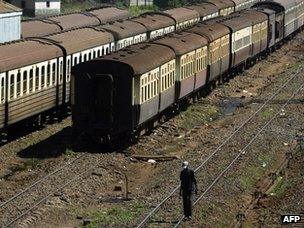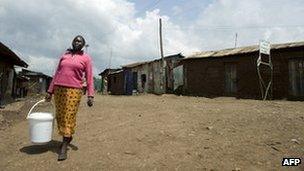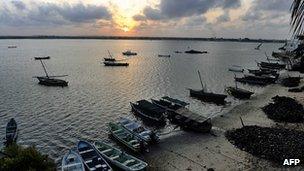Viewpoint: Will corruption kill off Kenya's Vision 2030 plans?
- Published

Konza City is an example of the modern country Kenya hopes to project - but will the old forces of corruption sabotage the great leap forward?
Economist James Shikwati asks whether Kenya's ambitious Vision 2030 plan can bring the country out of a cycle of corruption and economic stagnation.
Since independence in 1963, Kenya's great development plans have been held back by the plunder of government resources.
The attitude that what belongs to the public can be taken with impunity has been seen as one of the most serious impediments to development in the country - and by extension, the rest of Africa.
Lawrence Reed, president of the Foundation for Economic Education, described it as: "What belongs to you, you tend to take care of; what belongs to no-one or everyone tends to fall into disrepair."
A new constitutional order, however, has been created to reduce the arbitrary and discretionary powers used by politicians and civil servants to steal public money.
Kenyans voted for the new constitutional order in August 2010 with the hope of liberating the country from a curious type of "state capture, external;" the system which has allowed Kenya's leaders to commandeer state resources and keep power within ethnic boundaries.
Boosting growth
Dismantling the old structure will not happen overnight, however. Kenyans will have to try and adapt, and the changes to the way the country has been run will take some time to take effect.
Vision 2030 is the name of the economic plan the country's leaders hope will be the country's great leap forward but it is not the country's first development plan.

Revitalising Kenya's railway network will be a crucial part of the plan
In 2003, the Kenyan government sought to boost an economy whose growth rate was low - only 1.1%.
It put in place a short term initiative dubbed Economic Recovery Strategy for Wealth and Employment Creation. In 2005, a government-sponsored constitutional referendum, external aiming to overhaul areas such as land ownership and the president's executive power was proposed.
Kenya's Sessional Paper No 10 in 1965 had directed the government to spend resources only in areas with high potential. The outcome was political exclusion and economic marginalisation of communities in the arid north and rural areas of Kenya, away from big cities such as Nairobi and Mombasa.
In response, the government set up a National Economic and Social Council in October 2006 to oversee Kenya's long-term planning. From this came "Kenya Vision 2030: A Globally Competitive and Prosperous Kenya". Kenya's Vision 2030 was launched by the country's coalition government on 10 June 2008.
Technology hub
Its intent was to change Kenya's political framework so that lawmakers were obliged to plan further into the future than the length of their own careers.
Vision 2030's cost is yet to be finalised. It is based on three pillars - economic, social and political.

Most Kenyans continue to live in poverty
The economic aim is for an average GDP growth rate of 10% per year from 2012 and to ensure all of Kenya's regions see development. The country's economy has grown at an average of 3.5% since 2008, below the sub-Saharan African average of 5.5%.
The key elements of Kenya's economy include wholesale and retail, transport and communication, manufacturing, financial services and agriculture and forestry.
The social pillar, meanwhile, is intended to build "a just and cohesive society with social equity, external", according to the plan's director general, Mugo Kibati.
Kenya is preparing for elections, which are set for 4 March next year. The vote is expected to be a barometer measuring Vision 2030's ability to create a truly democratic political system respecting the rule of law and protecting the rights and freedoms of all Kenyans.
The chair of Kenya's Vision 2030 Delivery Board, James Mwangi, argues that the initiative is yet to be felt by ordinary Kenyans because more emphasis has been put on infrastructure and institution building, external.
The Vision 2030 initiative is keen to align with regional economic communities such as the East African Community, Common Market for Eastern and Southern Africa (Comesa) and Community of Sahel-Saharan States among others.
This has influenced key flagship projects including Lamu Port and the Lamu-Southern Sudan-Ethiopia Transport Corridor. When complete, this project is expected to connect Kenya to Bangui in the Central African Republic and Douala across the continent in Cameroon.
Other developments include:
Improving Nairobi's commuter rail and turning small railway stations settlements into mini cities
Investing in green energy (geothermal power)
Building an electricity transformer factory and a solar panel factory
Setting up an international sports academy
Building the tech hub popularly referred to as Konza City
The construction of the ambitious port and railway networks at a projected cost of $23bn (£14.2bn) is likely to attract support from growing economies.
China, for example, has agreed to finance the recalibration of the existing Kenya-Uganda Railway, external to the tune of $2.6bn (£1.6bn). This will mean bigger loads can be carried at much faster speeds - up to 125 km/h compared to less than 25 km/h at the moment.
People in the arid north of the country have for the last 50 years been mostly excluded from political and economic developments.
Building better transport links in the northern corridor might address their exclusion.
This, together with news of oil being discovered in Turkana in the north-west and the possible gas deposits off the Lamu coast gives Vision 2030 much-needed impetus.

Stretches of Kenya's coastline will be transformed by the new Lamu port
The recent discovery of massive underground water reserves in northern Kenya gives extra hope to delivering this new vision.
All these natural resources mean Kenya now has extra bargaining power when it looks for overseas investment.
It however remains to be seen if Vision 2030 will change the attitude that has affected Kenya's development until now.
Changing role
Many Kenyans' attitude to the public purse can be summed up with the following phrase: "Kwani pesa ni ya mamako?" ("Do public funds belong to your mother?"). The question loosely translates as a motivation to plunder public resources because it does not belong to any one person.
Similar sentiments are behind the desire for political power, which ethnic communities refer to as the "buses" to deliver opportunities for political fraud, euphemistically referred to as "eating".
The quest to "eat" public resources can lead to an increase in clan and ethnic violence as communities jostle to control the country's new county governments.
Kenya's Vision 2030 has to address new challenges because the recent discovery of natural resources were not part of the original plan. It also has to focus on the changing role of Africa in the ever evolving global dispensation.
For Kenya's Vision 2030 to be effective, it has to take heed of a famous Chinese saying: "Resources are the mother of wealth; hard work is the father of wealth - only the two combined can produce wealth."
James Shikwati is the founder of Inter Region Economic Network and publisher of The African Executive.